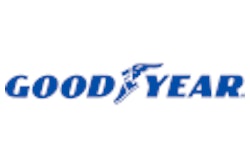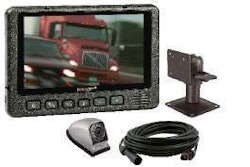Stay on top of these 12 PM items to escape big repair bills and frequent downtime.
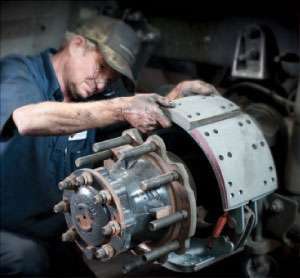 Kirk Beckham performs brake work at Southland International Trucks in Tuscaloosa. Preventive maintenance scheduled at home costs much less than emergency work on the road.
Kirk Beckham performs brake work at Southland International Trucks in Tuscaloosa. Preventive maintenance scheduled at home costs much less than emergency work on the road.It’s no secret that emergency repairs far from your home can cost several times the repair bill in your local shop. That premium, plus the efficiency of scheduling preventive maintenance work at your convenience, means you get a great return for the effort put into diligent preventive maintenance. Spending up to 30 minutes a day on pre-trip and post-trip inspections often will uncover repairs that should be addressed at once, as well as items that you can work into your next scheduled maintenance.
“A lot of owner-operators pay attention to their tires and get their oil changed, but there are a lot of other components on the truck that have life expectancies,” says Bill McClusky, maintenance management consultant at ATBS, the nation’s largest owner-operator financial services provider. Planning PM with regard to those life expectancies is “being proactive in maintenance, not reactive,” he adds.
Tire failure
Air pressure that is frequently too high or too low for the loads you’re hauling will end up reducing tire longevity and hurting the casing for retreading.
“An 11R22.5 tire typically will have 110 psi imprinted on the sidewall,” says Tim Miller, marketing communication manager at Goodyear Commercial Tires. “If you’re not carrying a full load, you can probably get away with and maybe improve your tire wear by running 85 or 90 psi.”
A truck out of alignment will produce uneven tire tread wear. A visual inspection might give you an idea that tread depth is uneven. You might also run your hands across the tread to feel for unevenness.
How to prevent
• Daily pressure readings are ideal, Miller says, but measure at least weekly. Measure also when your load weight changes.
• Check grooves for rocks and other objects that could work their way into the casing.
• Inspect sidewalls and shoulders for abrasions and punctures.
Clogged Radiator Fins
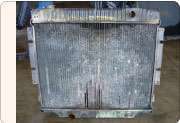 Regularly spraying water forward through the radiator will minimize corrosion, enhance air flow and reduce the likelihood of a time-consuming disassembly of the fins for cleaning.
Regularly spraying water forward through the radiator will minimize corrosion, enhance air flow and reduce the likelihood of a time-consuming disassembly of the fins for cleaning.The radiator has a tendency to collect dirt and debris on the fins, says Jim Hess, president of Midway Truck Service. As this builds up, cooling efficiency diminishes. This is especially true in summer, when insects, pollen, rust and other airborne materials increase.
How to prevent
When you wash your truck, spray water forward from the engine side out through the radiator, air-to-air cooler and the condenser to dislodge the debris. If this is done often enough, it will minimize the need to disassemble the units from the front of the radiator to clean them individually. Disassembly doesn’t necessarily require disconnecting the condenser from the A/C system, but it is a two-hour job that can be eliminated, Hess says.
Dead batteries
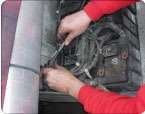 To avoid battery problems, regularly inspect terminals and other connections for corrosion and loose fittings.
To avoid battery problems, regularly inspect terminals and other connections for corrosion and loose fittings.Running lights and electrical appliances with the engine off can weaken your batteries. Do it often enough and eventually you’ll be struck with dead batteries.
Check your dashboard volt meter to see if you’re adequately charging the batteries, says John E. Dolce, a fleet maintenance consultant affiliated with the Wendel Duchscherer consulting firm. The charge should range between 12 and 14.5 volts.
In addition, you’ll want to check the ammeter to measure the flow of current from the batteries. The reading is usually 150 to 200 amps.
How to prevent
• Verify that electricity is flowing out of your batteries.
• Check battery terminals and other connections for corrosion. Carry electrical contact cleaner and dielectric grease for connection cleaning.
• Make sure batteries are securely mounted in their trays. Vibrations and hitting potholes can loosen batteries.
Brake failure
Under normal brake operation, trailer brakes apply a fraction of a second before the tractor drive brakes, which are then followed by the steer brakes. If that brake sequence is out of adjustment, drive brakes or steer brakes will wear faster than normal, Dolce says.
“Look at brake linings on all axles,” he adds. “If the trailer’s worn more than the tractor brakes, that’s desirable. If the tractor’s brakes are worn more than the trailer, you have not only a wear problem but also an [alignment] problem.”
Dolce prescribes a second type of brake check. After a run, hold your hand about 6 inches from the axle at each wheel end to feel the heat. “If the wheels are cold, you’ll know they’re not working,” he says.
How to prevent
• During pre- and post-trip inspections, check your brake system for leaks. Fix leaks before hitting the road.
• Make sure low-air alarms and the compressor work properly.
• Use brake backing plates on the axles to minimize the amount of abrasive material that can get to the lining and drums and accelerate wear. The plates make it more difficult to inspect the lining, drums and seals, but the long-term benefits are significant, Hess says.
Water in fuel tanks
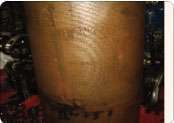 This wet sleeve cylinder liner from the engine block is marked by cavitation, or tiny bubbles that eat into the surface when nitrite levels in coolant are too low. Cavitated liners allow coolant to get into engine oil.
This wet sleeve cylinder liner from the engine block is marked by cavitation, or tiny bubbles that eat into the surface when nitrite levels in coolant are too low. Cavitated liners allow coolant to get into engine oil.When water is in the fuel tank, it can be drawn into the fuel system, which can reduce performance and damage the fuel system. Another potential problem with failing to drain water from fuel tanks: cultivating biological growth, McClusky says.
The problem, which has grown with the switch to ultra-low sulfur fuel, often leads to a “pretty big expense, and it can cause headaches, because it can be hard to clean out,” he says. McCluskysays some owner-operators have had to replace their tanks.
You can detect the presence of a biological growth when you change fuel filters and see a black deposit. You can also shine a flashlight in the fuel tank and see the growth, McClusky says.
If you detect a growth, a biocide product will kill it, leaving the dead material floating in the tank. Some biocides help the removal process by breaking up the material.
How to prevent
• Every 30,000 to 50,000 miles, when your truck’s in for service, have water drained from the fuel tanks.
• You can do it yourself by unscrewing the drain plug at the bottom of the tank. Water, which is heavier than fuel, drains first. Replace the plug when the drainage turns from clear to amber-colored.
Cooling system dysfunction
McClusky notes that half of major engine failures result from improper cooling system maintenance.
In conventional coolant, nitrites form a barrier against cavitation, manifest by holes in the wet sleeve cylinder liner in the engine block. The problem arises when nitrite levels drop too low to protect the liners. Cavitated liners allow coolant to get into the engine oil.
If you have an electrical ground fault where current runs through the engine block to find a ground, the process rapidly depletes the nitrites. Electrical problems soon follow. Eventually, you’re facing an in-frame overhaul. McClusky has seen a truck using conventional coolant break down after just 2,000 miles because an electrical problem led to cavitated liners.
The emergence of extended-life coolant has caused confusion as to how often different coolants should be checked. To avoid problems, don’t mix conventional coolant with the extended-life type.
How to prevent
• Monitor nitrite levels with coolant test strips.
• Use extended-life coolant to increase longevity and reduce maintenance frequency. It’s good for 600,000 miles, with an interval at 300,000 miles when you add an extender additive, available from major oil manufacturers.
• Pay for a coolant analysis, similar to an oil analysis. It can catch nitrite depletion that may be linked to an electrical problem.
Broken belts, clamps and hoses
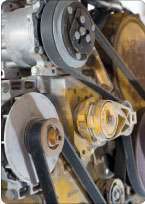 Inspecting belts, hoses and clamps is especially important during extreme temperature changes, when expansion and contraction can damage them.
Inspecting belts, hoses and clamps is especially important during extreme temperature changes, when expansion and contraction can damage them.Abrasion, heat, oil, ozone and dramatic temperature differences can weaken belts, hoses and clamps. If these simple devices fail, you could end up on the side of the road with an overheated engine, loss of the electrical charging system or a cooling system that doesn’t work. Over time, extreme heat can deteriorate rubber compounds.
Hose leaks often start with simple chafing of hoses. “Air-conditioning system or water hoses are good examples,” says Hoyt Moore, president of Hoyt’s Truck Center. “We average two to three service calls a month with hoses with rub holes in them.”
Chafing air hoses are the latest “hot buttons” for state inspectors, Hess says. Some are writing tickets for hoses showing rub spots, even though no leak has developed, he says.
How to prevent
• Check belts for tightness and damage from heat. Look for signs of glazing on the belt’s exterior. Replace if cracked, frayed or torn.
• Replace bulging or cracked hoses.
• Tighten loose clamps. Replace if corroded, cracked or worn.
• Carry spare belts, hoses and clamps.
• Be attentive to brake hoses on the axles and secure them properly so they do not rub.
Dry U-joints
New longer-lasting U-joints don’t need to be greased as often, but that doesn’t mean you can ignore their maintenance. “People feel they can save maintenance by not greasing as much,” Moore says. “They’re trying to save money on the front end, and it costs them on the back end. We’ve had some trucks in here where the cost to repair has gone as high as $10,000, with an average of $3,500 to $5,000.”
If grease doesn’t ooze out of all four channels, one of them is probably dry. Skimp on your greasing, and the U-joint can come loose. “At 60 mph, the driveline is ripping valves, lines, air bags, anything it can possibly come in contact with,” Moore says. “We’ve seen it break rear ends.”
How to prevent
Moore recommends greasing U joints every 10,000 miles, which is more frequent than specified by manufacturers. Greasing takes less than 30 minutes to complete. A tube of grease costs about $7.
Saturated air dryer
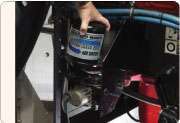 It’s easy to overlook the air dryer because of its lengthy service interval, but its cartridge should be checked regularly for saturation.
It’s easy to overlook the air dryer because of its lengthy service interval, but its cartridge should be checked regularly for saturation.Since the air dryer service interval is about 300,000 miles for a long-haul truck, operators tend to forget about air dryers, and particularly the cartridge that absorbs moisture. Yet if the cartridge gets saturated, moisture creeps into air system valves and can cause corrosion. In cold weather, in can freeze. “If you’re not paying attention, it can be a full day of downtime,” McClusky says.
How to prevent
• During your daily truck inspection, drain water from the air tanks via the drain valves. If you notice a significant amount of water coming out, it’s a good sign the cartridge is saturated and should be replaced by a trained mechanic. Cartridges range from $85 to $300.
Air pressure loss
The air compressor pumps air into the reservoir tanks for the brake system, while the air compressor governor controls the in and out points of the air compressor to maintain pressure in the tanks. Neglecting the compressor can lead to loss of pressure. The dash gauge will give a warning.
Leaky connections are common. Although air hoses and lines are sturdy and built to last, they can become damaged.
How to prevent
• Perform pre-trip and post-trip inspections of hoses.
• Start the engine and listen for high-pressure leaks. Watch the air pressure gauge to ensure the truck is building air quickly.
• At full air pressure, release the parking brake and turn the engine off. Listen for any air leaks.
• Apply the brake pedal and listen for any air leaks. Continue pushing the pedal and watch the pressure gauge. The pressure should hold steady.
• Investigate any automatic warnings about the compressor.
• Inspect the glad hands. Make sure the rubber gaskets are free of cracks and seated properly. A failed gasket will cause air pressure to leak from the brake system.
Power divider failure
McClusky says a catastrophic failure of the power divider, or interaxle differential lock, can cost $5,000 to $7,000. The interaxle differential lock divides power to the two tandem drive axles, McClusky says.
“It can become catastrophic when it takes out the differential housing and it can even knock brake chambers off the axle housing,” he says.
The biggest cause of power divider failure is wheel spin, preventing the power divider from getting sufficient lubrication. This leads to metal-on-metal contact and metal shafts and gears getting chewed up.
Spin your wheels on ice, for example, and the problem might not appear until later. As you drive, the divider continues to grind away until it fails.
An in-cab control allows you to lock in the power divider, though McClusky says many operators don’t know how to use it. When the power divider goes out, the operator says it’s not his fault because he didn’t use it. “That’s like pleading guilty” in a criminal trial, McClusky says.
How to prevent
• At least once a year, have the transmission and drive axle checked out.
• Have a differential oil analysis performed. “Catching it early with differential oil analysis can reduce it to about a $1,500 repair,” McClusky says.
Fuel filter replacement
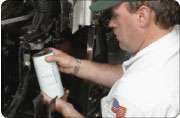 Replacing a fuel filter before it gets clogged can head off a power loss that could force a shutdown.
Replacing a fuel filter before it gets clogged can head off a power loss that could force a shutdown.If your truck starts to run poorly, loses power and eventually shuts down, the fuel filter may be too restricted. Injector problems also might be traced to a clogged fuel filter, says Jeff Sass, Paccar Parts general marketing manager.
Dolce points out that fuel filters don’t have a bypass built into the fuel system like oil filters in the oil lubrication system.
“Plugged fuel filters will restrict the fuel flow, plus allow water or particles into the fuel system, causing premature deterioration and failure,” Dolce says.
A road call to replace a fuel filter could cost $200, and up to $2,000 if a tow and injector replacement are required, Sass says.
How to prevent
• Include checking fuel filter as part of your regular trip inspections.
• Carry a spare with you to make a change. If you replace the filter, prime the system to restart the truck. n

